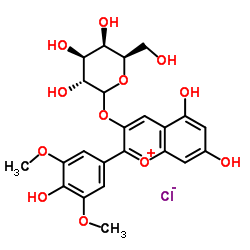氯化锦葵色素-3-O-半乳糖苷

氯化锦葵色素-3-O-半乳糖苷结构式

|
常用名 | 氯化锦葵色素-3-O-半乳糖苷 | 英文名 | Malvidin-3-O-galactoside chloride |
|---|---|---|---|---|
| CAS号 | 30113-37-2 | 分子量 | 528.890 | |
| 密度 | N/A | 沸点 | N/A | |
| 分子式 | C23H25ClO12 | 熔点 | N/A | |
| MSDS | 中文版 美版 | 闪点 | N/A |
氯化锦葵色素-3-O-半乳糖苷用途Malvidin-3-氯化半乳糖苷是一种花青素单体,可诱导肝细胞癌(HCC)细胞周期阻滞和凋亡。Malvidin-3-半乳糖苷氯化物抑制活性氧的产生和积累。Malvidin-3-半乳糖苷氯化物具有抗肿瘤功能[1]。 |
| 中文名 | 氯化锦葵色素-3-半乳糖苷 |
|---|---|
| 英文名 | malvidin-3-galactoside chloride |
| 中文别名 | 氯化锦葵色素-3-O-半乳糖苷 | 氯化锦葵色素 3-半乳糖苷 | 樱草灵 |
| 英文别名 | 更多 |
| 描述 | Malvidin-3-氯化半乳糖苷是一种花青素单体,可诱导肝细胞癌(HCC)细胞周期阻滞和凋亡。Malvidin-3-半乳糖苷氯化物抑制活性氧的产生和积累。Malvidin-3-半乳糖苷氯化物具有抗肿瘤功能[1]。 |
|---|---|
| 相关类别 | |
| 体外研究 | Malvidin-3-半乳糖苷氯化物(50,100,200μg/mL;24、48、72h)对Huh-7细胞有明显的细胞毒性,50和100μg/mL对48h无明显影响。Malvidin-3-半乳糖苷氯化物在72小时时对Huh-7细胞具有显著的细胞毒性作用[1]。Malvidin-3-氯化半乳糖苷(50-200μg/mL)阻止S期细胞,伴随着G1期细胞减少,S期细胞增加[1]。Malvidin-3-氯化半乳糖苷(50-200μg/mL;72小时)诱导Huh-7细胞凋亡[1]。Malvidin-3-氯化半乳糖苷(50-200μg/mL;72小时)以剂量依赖性方式显著增加半胱氨酸蛋白酶-3、裂解半胱氨酸蛋白酶-3和裂解PARP的水平[1]。Malvidin-3-氯化半乳糖苷(50-200μg/mL;12小时)抑制活性氧的产生和积累[1]。Malvidin-3-氯化半乳糖苷(50-200μg/mL;12小时)以剂量依赖性方式显著降低磷酸化ERK(p-ERK)水平。200μg/mL的Malvidin-3-半乳糖苷氯化物显著增加p38和JNK(p-p38和p-JNK)[1]的磷酸化水平。Malvidin-3-氯化半乳糖苷(50-200μg/mL;12小时)抑制Huh-7细胞的迁移和侵袭[1]。 |
| 参考文献 |
| 分子式 | C23H25ClO12 |
|---|---|
| 分子量 | 528.890 |
| 精确质量 | 528.103455 |
| PSA | 191.67000 |
| 外观性状 | 固体 |
| 储存条件 | 密封、在2 ºC -8 ºC下保存 |
| 稳定性 | 如果遵照规格使用和储存则不会分解,未有已知危险反应 |
| 计算化学 | 1、 疏水参数计算参考值(XlogP): 2、 氢键供体数量:7 3、 氢键受体数量:12 4、 可旋转化学键数量:6 5、 互变异构体数量:41 6、 拓扑分子极性表面积(TPSA):180 7、 重原子数量:36 8、 表面电荷:0 9、 复杂度:669 10、同位素原子数量:0 11、确定原子立构中心数量:5 12、不确定原子立构中心数量:0 13、确定化学键立构中心数量:0 14、不确定化学键立构中心数量:0 15、共价键单元数量:2 |
| 更多 | 1. 性状:未确定 2. 密度(g/mL,20℃):未确定 3. 相对蒸汽密度(g/mL,空气=1):未确定 4. 熔点(ºC):未确定 5. 沸点(ºC,常压):未确定 6. 沸点(ºC,KPa):未确定 7. 折射率:未确定 8. 闪点(ºC):未确定 9. 比旋光度(º):未确定 10. 自燃点或引燃温度(ºC):未确定 11. 蒸气压(Pa,20ºC):未确定 12. 饱和蒸气压(KPa,20ºC):未确定 13. 燃烧热(KJ/mol):未确定 14. 临界温度(ºC):未确定 15. 临界压力(KPa):未确定 16. 油水(辛醇/水)分配系数的对数值:未确定 17. 爆炸上限(%,V/V):未确定 18. 爆炸下限(%,V/V):未确定 19. 溶解性:未确定 |
| 个人防护装备 | Eyeshields;Gloves;type N95 (US);type P1 (EN143) respirator filter |
|---|---|
| 危险品运输编码 | NONH for all modes of transport |
| WGK德国 | 3 |
|
Bog bilberry (Vaccinium uliginosum L.) extract reduces cultured Hep-G2, Caco-2, and 3T3-L1 cell viability, affects cell cycle progression, and has variable effects on membrane permeability.
J. Food Sci. 75(3) , H103-7, (2010) Bog bilberry (Vaccinium uliginosum L.) is a blue-pigmented edible berry related to bilberry (Vaccinium myrtillus L.) and the common blueberry (Vaccinium corymbosum). The objective of this study was to... |
|
|
Phenolic compounds and bioactivities of pigmented rice.
Crit. Rev. Food Sci. Nutr 53(3) , 296-306, (2013) The pigmented rice has been consumed in China, Japan, and Korea for a long time. It has been used for strengthening kidney function, treating anemia, promoting blood circulation, removing blood stasis... |
|
|
Direct effects of Vaccinium myrtillus L. fruit extracts on rat heart mitochondrial functions.
Phytother Res. 27(4) , 499-506, (2013) In this study, the direct influence of bilberry (Vaccinium myrtillus) fruit extracts (aqueous and ethanolic) rich in anthocyanins on the oxidative phosphorylation of isolated rat heart mitochondria wa... |
| PRIMULINE FOR MICROSCOPY |
| PRIMULIN |
| 5,7-Dihydroxy-2-(4-hydroxy-3,5-dimethoxyphenyl)-3-chromeniumyl D-galactopyranoside chloride |
| PRIMULIN CHLORIDE |
| EINECS 250-055-1 |
| D-Galactopyranoside, 5,7-dihydroxy-2-(4-hydroxy-3,5-dimethoxyphenyl)-1-benzopyrylium-3-yl, chloride (1:1) |
| MALVIDIN-3-O-GALACTOSIDE CHLORIDE |
| malvidin 3-galactoside |


